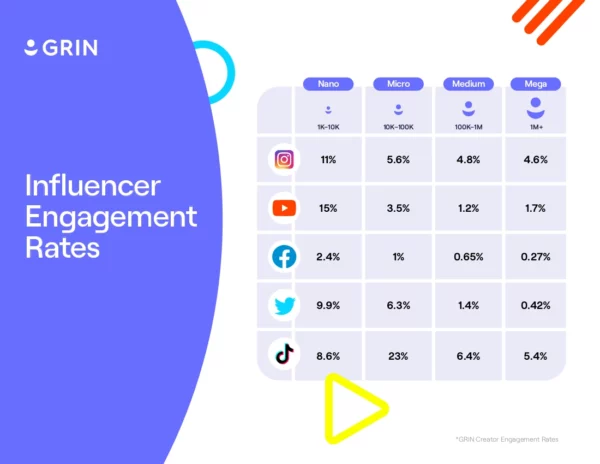August 11, 2022
Is It Possible for Nano Influencers to Go Viral With Brand Partnerships?

Remember the time Bobby Boucher showed up at halftime and the Mud Dogs won the Bourbon Bowl?
No?
OK, never mind.
The point is, bigger isn’t always better. And sometimes, the “underdog” can perform just as well as the stars—especially when it comes to influencer marketing (and Adam Sandler movies).
Over the past couple of years, nano influencers have been on the rise as more and more marketers move away from the larger, more expensive names and start winning with smaller, more targeted creators who genuinely love their brands and products.
In this blog, we’ll get to know some of these niche creators and go over the steps nano influencers can take to ensure their brand partnerships are a success. Then, we’ll look into some brands making the most of their nano influencer partnerships.
What is a nano influencer?
Nano influencers generally have between 1,000-10,000 followers on a given social media channel.
Although their audience size is the smallest of all influencer types, nano influencers tend to have higher engagement rates than their larger counterparts. The ideal engagement rate for a nano influencer varies by platform but should always be more than 2%.

Nano influencers usually fall within a specific niche, meaning any company they align with has a high chance of converting with their like-minded audience.
How nano influencers become invaluable brand partners
Whether you’ve just been offered your first brand partnership or you have experience with a few, check out these tips for supercharging your performance and delivering amazing results.
1. Partner with brands whose products you genuinely love.
When you are genuinely excited about a product, your audience can tell … which also means they can tell if you’re promoting something you don’t love. Partnering with brands whose products you don’t use can cause your followers to lose trust.
However, this doesn’t mean you can only partner with brands whose products you’ve been using all your life. If an unfamiliar brand reaches out about a partnership, ask about trying a sample to see if you enjoy using their products. If you do, then great—it’s time to partner! If not, thank them for the offer and tell them that you’re not the best fit for their campaign. They’ll appreciate the honesty.
2. Don’t make branded posts drastically different from your typical posts.
Your followers listen to you because they like what you have to say and the way you express yourself. When branded content looks, sounds, or feels different than your usual vibe, it may not perform well. It can seem less genuine, and people may be suspicious of the branded messages you’re sharing.
If a brand has a list of things you must include in your posts, think about how you can mesh these requirements with your style. The more true-to-you these posts seem, the better they’ll perform.
3. When in doubt, talk about a product like you’re describing it to your best friend.
If this is your first brand partnership, you may find it’s a bit difficult to feel natural while talking up a product. To keep it more authentic, loosen up and act like you’re describing it to your best friend over a video chat. Pick a few aspects of the product you really love, and be sure to highlight them. Consider talking about the impact it’s had on your life if you’ve been using it for a while.
Nano influencer trends to look out for
More monetization options for nano influencers
Social media companies have finally begun to realize how critical creators are to the success of their platforms.
YouTube, Instagram, and Pinterest have invested the most into making their platforms creator-friendly. Facebook, Linkedin, Twitter, and TikTok have also launched campaigns to stimulate high-quality creator content on their platforms. Expect all platforms to roll out more payment and growth opportunities for creators in 2023 and beyond.
Brands prioritize nano influencer partnerships.
Nano influencers have grown in popularity over the last few years, largely with the help of TikTok. The platform’s organic content from “everyday” creators has proven its ability to go viral overnight and far extend the reach of its original intended audience. And because of nano influencers’ increased viral potential, more than 90% of U.S. marketers said they want to form partnerships with influencers who have between 5,000 and 100,000 followers this year.
More nano influencers earn long-term partnerships.
Most nano influencers produce content at the same level as some of the most popular macro and celebrity influencers. Additionally, smaller influencers almost always have far superior engagement rates.
As a result, brands have begun to lock these high-performing creators in for long-term partnerships. Not only do they produce content at an amazing clip, but they are also seen as an investment with plenty of room for growth.
User-generated content: Get on your favorite brands’ radars.
If you want to partner with a brand, you can DM them, but that might not always work. They may not check their social media messages often, or you might just be one message among many from creators looking to partner with them.
Instead, differentiate yourself by talking about the brand in an organic post (be sure to tag them and use any relevant hashtags). Brands love when fans talk about their products online, and many may even reach out about resharing your content on their pages.
Plus, when you post organically about a product, brands can see how you perform. They can check out your post and see if they think you’d make a good fit for the brand, and if you have a high engagement rate on the post, they may be interested in a partnership.
Will Padilla—a nano influencer on TikTok—recently found himself in a similar situation.
While Will’s content generally centers around tech advice for young professionals, he couldn’t help but share his love for the “world’s greatest pants” from Lululemon.
Shortly after posting, Lululemon “dueted” Will’s post from its branded channel.
@lululemon #duet with @sellthatsaas We’re flattered. #lululemon #abcpants ♬ original sound – .tyronic
“[The original post] was a 100% authentic post,” Will said. “I was literally shocked when they dueted me.”
Examples of major brands leveraging nano influencer content
La Croix
Sparkling water brand La Croix sources quality UGC from nano influencers using hashtags like #LaCroixlove and #LiveLaCroix and features its favorite posts on the company’s various social media channels. The company also has an option for fans to upload photos to its website to be featured in a virtual scrapbook dedicated to brand love.
Coca-Cola
Coca-Cola was one of the first major brands to jump on the nano influencer train. The company gives all its fans a chance to become a #cokeambassador and boosts the best quality content to its 2.8 million Instagram followers.
Sperry
Sperry regularly partners with nano influencers, even giving some of them a budget to promote their favorite products to their followers online. The brand keeps a vigilant eye out for quality collaborators who are already uploading content using the brand’s official hashtags #sperry and #sperrystyle.
Q&A: What smaller creators look for in their favorite brands
Katryna Ton is a GRIN senior customer success manager and recent MBA graduate of UC Irvine. She is also a fashion and lifestyle content creator who has partnered with numerous brands, including Liquid I.V., Cozy Home, and Parachute Earth.
What does brand outreach typically look like in your experience? Do you reach out to them, them to you, or a combo of both?
Brands reach out to me, but I will also pitch myself to them if I really want to work with them, and I believe I am a good fit.
Proper brand outreach is usually an email. Brands will email me, introduce themselves, and see if I am interested in partnering or collaborating with them.
What is your payment structure? (Gifting, commission, flat rate, etc.)
All of the above. But it depends on the brand or what we negotiate. I have worked on campaigns with all three types of payment structures.
What type of compensation do you recommend—or what is most realistic—for nano influencers to go after when first getting started with brand partnerships?
For nano influencers, there is nothing wrong with accepting gifting as a form of compensation, especially when you are just starting out.
On the other hand, if you know you create great content, UGC content creation is a great way to partner with brands on a possible paid basis. And if you love a brand and are passionate about sharing consistently over time, commission-structured campaigns can be very lucrative if you have an engaged following who trusts your opinions.
What type of collaboration works best?
Different collaborations work best for different reasons, but as a guarantee, paid collaborations work best because there is an obligation for the creator to follow through. It also gives the brand and creator more room to negotiate on the number of deliverables, content rights, usage, etc. This all depends on the brand’s budget as well.
What are some current trends you’re seeing among nano and micro influencers in your space?
Nano and micro creators want the opportunity to be paid. So if a brand thinks their content is high quality enough, then the brand should consider paying them. This trend is starting to push nano and micro creators to create content for brand usage rather than creating and posting content to their own channels for brand awareness.
What trends do you see moving forward?
TikTok is the social platform to be on if you want to grow fast, but you have to be consistent. Diversifying your social presence is also important, but having one channel as your main presence helps establish credibility.
More and more people want to be influencers and creators, so nano and micro influencers have more opportunities now than they did before, and follower count is starting to matter less.
Key takeaway: Nano influencers hold a lot of power in the creator economy.
Nano influencers offer marketers something that’s getting harder for the big names to compete with: brand love. By finding the right brands to partner with, you can leverage your authority to earn free products and get paid.
See also: Influencers Talking Brands—What Makes Them Say Yes?!
